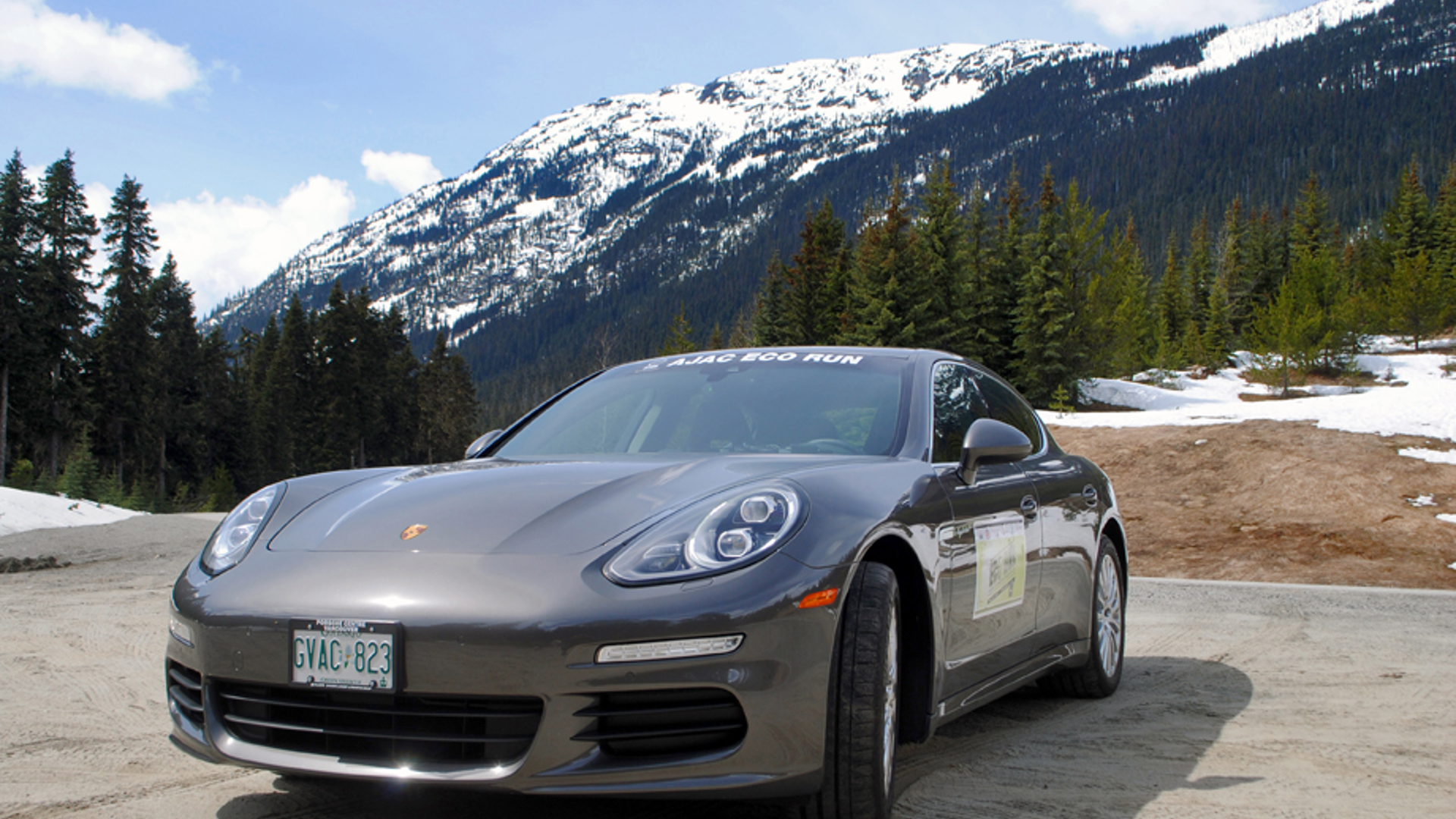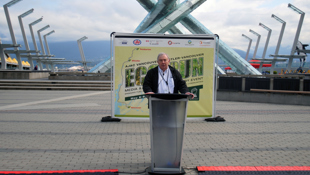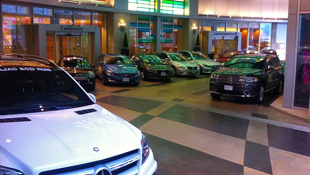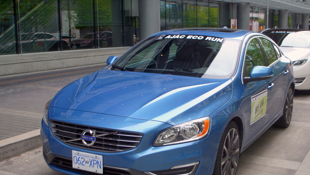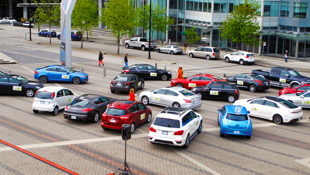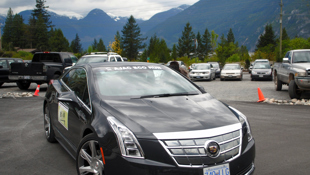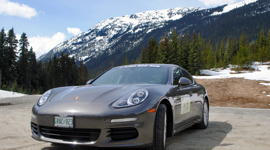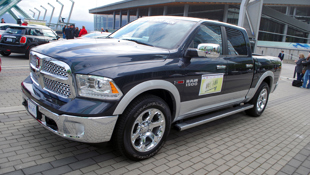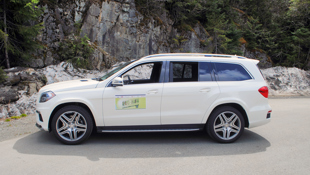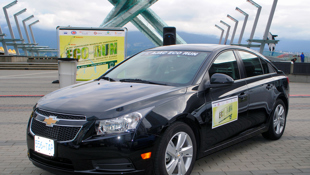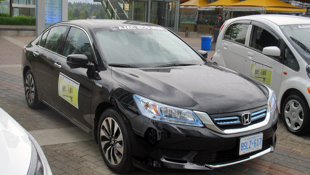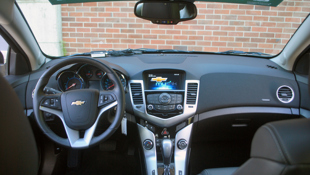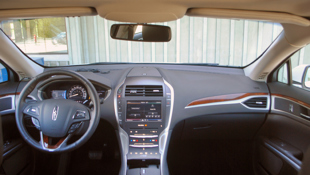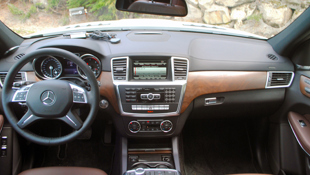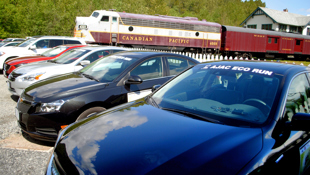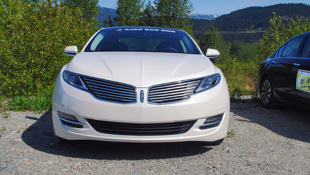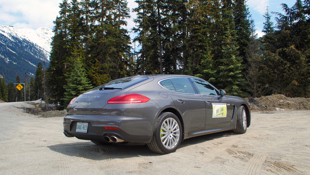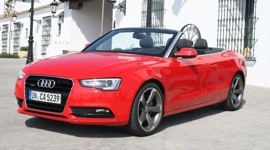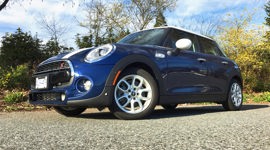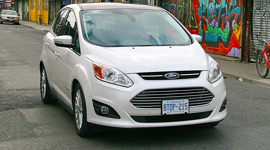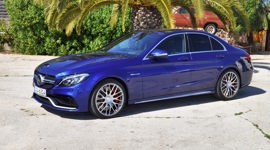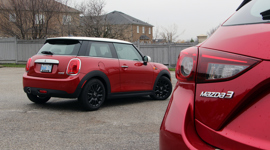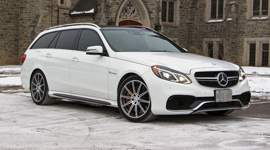Vancouver seemed the obvious choice for the Automobile Journalists Association of Canada (AJAC) to launch its third annual Eco-Run last week. You’re probably thinking, I know Vancouver — but what is Eco-Run?
It’s two things, really.
First, it’s a rolling showcase of 19 purportedly green vehicles, driven over three days by 19 select AJAC writers. Each car features some fuel-efficient technology. This year, there were electric vehicles (EVs), hybrids, diesels and some exceptional naturally aspirated engines. The purpose of this green parade is to show consumers you have a choice in how big your carbon footprint is next time you purchase a vehicle.
But most of us aren’t buying a car right now. So Eco-Run is also a competitive demonstration of fuel-efficient driving by us writers.
During the six legs of the tour through British Columbia’s scenic Sea-to-Sky Corridor, our driving techniques were measured by data-gathering ‘loggers’ designed by computer engineers at MyCarma. They tracked acceleration, braking, speed, turns and so on, all of which affect fuel consumption.
To level the driving field, realities like engine size, or utter lack of gasoline engine, were factored in. Otherwise we’d be comparing apples and orange juice.
The most efficient driver of the week wins the vaunted ‘Green Jersey’, a tradition dating back hundreds of days to last May.
The cars & their numbers
Not all green auto tech is equal and, until recently, not much was very fun to drive. In previous Eco-Runs, some participants would bag the keys to the most luxurious and sportiest vehicles, then disappear. So this year, before each leg, the Eco-Run coordinator alphabetically assigned the cars below to names arbitrarily drawn from a basket. (If a writer had already driven the selection, their name went back in.)
This list includes all the 2014 Eco-Run vehicles, plus their average fuel consumption numbers throughout the six legs (treated to MyCarma’s fair-play algorithm) and as-driven or entry-level prices.
NB: The overwhelming majority of our driving was on highways. Precipitous BC highways. So EnerGuide numbers wouldn’t necessarily match road conditions. Bold italics indicate a vehicle that beat its published highway fuel economy stats. Boldface means it came within 10 percent.
Cadillac ELR — 4.65 L/100km; from $78,250
Chevrolet Cruze Turbo Clean Diesel — 5.69 L/100 km; from $25,045
Ford C-MAX Energi — 4.41L/100 km; $42,864
Honda Accord Hybrid — 4.63 L/100 km; $35,690
Hyundai Elantra — 6.16 L/100 km; $25,649
Kia Optima Hybrid — 6.07 L/100 km; $36,195
Lincoln MKZ Hybrid — 5.07 L/100 km; $50,350
Mazda3 SKYACTIV — 5.67L/100 km; $21,395
Mazda6 i-ELOOP — 6.57 L/100 km; $35,295
Mercedes-Benz E 250 BlueTEC 4MATIC — 6.07 L/100 km; $61,300
Mercedes-Benz GL 350 BlueTEC 4MATIC — 8.89 L/100 km; $89,380
MINI Cooper — 5.44 L/100 km; $25,740
Mitsubishi i-MiEV EV — 1.32 L/100 km; $33,998
Nissan Altima — 6.94 L/100 km; $29,128
Nissan Leaf EV — 1.6 L/100 km; from $31,698
Porsche Panamera S E-Hybrid — 5.6 L/100 km; $126,635
Ram 1500 EcoDiesel — 8.94 L/100 km; $70,090
Volvo S60 Drive-E T5 FWD — 6.81 L/100 km; $51,050
You’ll note the Porsche smashed its EnerGuide fuel ratings. Hooray. However, given its other number, it won’t be selling enough to save the world anytime soon. Plus, efficient driving means being light on the pedal, braking hard only in emergencies, and so on. Good luck with that.
Below is what I was assigned for the six legs. Uniquely on Day 2 of Eco-Run, only the first and last 40 km were tabulated into the competition. That’s because we shared and tested vehicles on a skid pad and dynamics course at Pemberton’s airport in the late morning. Then after lunch, we were offered several scenic drives to choose from. I got (won — it was a draw after all) the Porsche Panamera S E-Hybrid that afternoon. Once Big Brother wasn’t watching, its winning numbers above rocketed up.
My Eco-Run drives
Day 1 Morning — Chevy Cruze Turbo Clean Diesel, Central Vancouver to Squamish, 67.8 km
Ups: It’s Euro-sleek looking. It’s a diesel. (I like diesels. They’re actually the opposite of what most North Americans think.) And it’s very conservative on fuel. Even on this immensely hilly ride, I achieved 5.29 L/100 km.
Downs: What? What? It’s a touch LOUD. Plus, with the extra careful attention around the accelerator, it felt almost torpid. Maybe a touch of torpidity is understandable, given the event, but EVs sure don’t have this issue.
Day 1 Afternoon — Mercedes-Benz GL 350 Bluetec 4Matic, Squamish to Whistler, 57.7 km
Ups: It’s a diesel. It’s a Mercedes-Benz and doesn’t let you forget that: a lovely soft seat to sink into and adjust to perfection. Plus, I love that intuitive infotainment system.
Downs: It’s an SUV and drives like one. You don’t feel much of the road. And if you’re really out to save the world, do you really “need something this big for the kids and work”? The rest of the world doesn’t.
Day 2 Morning — Lincoln MKZ Hybrid, Whistler to Pemberton, 40 km
Ups: It’s not afraid to look different and features coolest roof of the event. On such a beautiful afternoon, who wouldn’t want to slide the roof back a la Skydome? Lovely multi-positioned seat.
Downs: Given the event’s raison d’etre, you couldn’t take advantage of the roof without creating drag and losing efficiency. Plus, the drive chain is a bit of a dullard.
Day 2 Afternoon — Porsche Panamera S E-Hybrid, Pemberton back to Whistler
Ups: It’s a four-door sedan and preserves some exceptionally nimble dynamics without announcing to the world that you’re turning 50 soon and need a new wife.
Downs: It’s really tempting to completely blow off the whole careful driving thing. If you’re going to spend the money for a performer that you can show off as an enviro-winner, it doesn’t trump the Tesla S but costs a good deal more.
Day 3 Morning — Honda Accord Hybrid, Whistler to Howe Sound, 63.2 km
Ups: The floating car in the green-lined dial gives real-time lessons in achieving excellent mileage. So I achieved an astounding logged 3.57 L/100 km. This is the real world — or a very steep imitation of it anyway.
Downs: It was another case of the accelerator feeling soft. After little response, you’re liable to thrust down when departing from a light if you’re being followed by other Eco-Runners and traffic.
Day 3 Afternoon — Volvo S60 Drive-E T5 FWD, Howe Sound to central Vancouver, 59.6 km
Ups: On the mountain inclines, that Drive-E is the little engine that could! Only four cylinders? Yes, but generously turbocharged. For clarification, see the Downs for this, Day 1 and Day 2’s mornings. Plus, its fuel-economy stats were realistic: city 9.4 L/100 km and highway 6.3 L/100 km. I achieved 6.39 L/100 km.
Downs: It was the only ride I left wanting more. (We didn’t have to hold back on the afternoon before when they turned off the data loggers. So I’d managed to slake my thirst in the Panamera.) Yes the S60’s efficient for that amount of power, but there are cheaper, more sensible ways to go green.
Some AJAC participants share their ups and downs
My biggest surprise was the Nissan Leaf. I tested its dynamics on the courses — with the logger turned off! I was delighted with its massive torque and firm grip. However, pushing it hard on the track swallowed heaps of power. A 300-metre slalom circuit used over a kilometre of its range. I didn’t get any time with the Mini Cooper. Even during the dynamics testing trades, its dance card was continually filled whenever I was hoping for a cuddle.
On the final day, I asked a few other writers for their impressions, positive and negative. Mostly, you’ll see, they were overwhelmingly positive even with their criticisms.
Alan Sidorov
Up: “The Cadillac ELR (which is basically an evolution of the Volt) is a step ahead. It covers a luxury compact market quite nicely and is still amazingly efficient.”
Up: “That the Cruzes and Mazdas stood up so well shows that the efficiency of more mainstream technology is growing. And for many people, that and the relative simplicity of that platform is more appealing than a hybrid which may have long-term complications.”
Downish: “For people who live in more remote areas, like me, a pure electric may not yet be the optimal choice. On the day we drove up to Whistler, where I live, it was fine. But imagine doing it with 20 cm of wet snow on the road and the heater on.”
Dan Heyman
Up: “I second Alan on the ELR. I actually didn’t have a chance to drive it in the electric mode, but fuel mileage wise, on a tiny gas engine, I still got a good report. The bottom line is: it’s a fun little car. Of all the cars here, I’d say it’s the most advanced looking. Even more than the Leaf or the i-MiEV.”
Still up: “I’ve always been a bit of a cynic with EVs, but now I’m starting to see that I may be wrong. I couldn’t believe just how many charging stations there are from here, Vancouver, up to Whistler. It’s almost like California. The fact that they have a fast-charger in Squamish... that is not something I ever would’ve imagined.”
Relentlessly up: “The cars I drove all played out the way I thought they would. The Leaf and the C-Max Energi and the Accord Hybrid... manufacturers are really coming along with this green high-tech.”
Rob Rothwell
Up: “I drove the Lincoln MKZ Hybrid and really enjoyed it. Very smooth and quiet, the type of cruising car I’d like to take on a trip. And when I looked at the onboard computer for fuel economy it was reading 5.6 L/100 km, which I thought was sensational for a luxury car of that calibre.”
Downish: “I learned that electric cars have limitations, specifically the Mitsubishi i-MiEV. I had to pull over and charge it. So you recognize that some vehicles are built for a specific purpose, which isn’t going through mountain passes on the highway. It’s for life in the city: commuting, doing chores, running around, but not a long-distance touring.”
Ben Yong
Up (countering Rob’s Down): “My biggest surprise was the i-MiEV because everyone knows it’s got quite a limited range but with the infrastructure all the way up to Pemberton, it was able to make it up there. That’s amazing! I even drove that car earlier to review it. In the city it just didn’t have the sort of range that it did on this trip.”
“Down”: “The only disappointment: I didn’t get to drive the Panamera but beyond that, whether it was diesel or hybrid or pure electric, I think everything was pretty awesome.”
Alexandra Straub
Up: “I really like the Ford C-MAX Energi. It’s the first time that I had driven it and with regards to efficiency, it did great. I made it from Vancouver to almost Horseshoe Bay (22 km) on electricity alone.”
Gently down: “I was driving the all-electric Nissan Leaf from Pemberton back to Whistler but a lot of it is uphill, so the range is going to be compromised, but it was still good. The thing’s a little rocket launcher, but not... It’s a GREEN rocket-launcher. A ton of fun to drive.”
Tim Miller
Up: “The Mini Cooper impressed me. With three cylinders it would probably get terrific mileage but it still went fairly well. It had that sporting nature.”
Down: “Hopefully, in the near future, we’ll be able to drive more than 40 or 60 km for a charge. I don’t know how well the full electric cars will cope in the winter. Back east we had a brutally cold winter and I don’t know how these cars would’ve stood up time-wise. You would’ve been anticipating 10, 15 or 20 km runs because it was so cold.”
Tim’s observation encapsulates the consensus: EVs are ready for city life but still need more infrastructure to conquer the country. However, if you do live in the city, the immediate torque an EV provides plus the possibility that you’ll never have to fill up at a gas station again combine to make EVs very compelling.
The most efficient drivers and those with the greatest room for improvement
After 67 hours of brilliantly clear skies, the cliché Vancouver weather set in midday Thursday, unfortunately drenching our big outdoor interface with the public. Nonetheless we had a positive end to Eco-Run 2014 with the most fuel-efficient drivers being announced at the Jack Poole Plaza, downtown Vancouver.
The best news is that the AJAC drivers scored an overall average of 88.2 percent. MyCarma’s president says he typically sees scores in the 60s and low 70s.
The greenest driver was long-time Toronto Star Wheels Correspondent Jim Kenzie with an impressive 99.5 percent score. I placed 5th, while fellow autoTRADER writer Greg Wilson was 6th, and our respective scores 93.9 and 93.7. Who brought the average down?
Without getting nastily specific, of the lower ten drivers, eight were Vancouverites.
